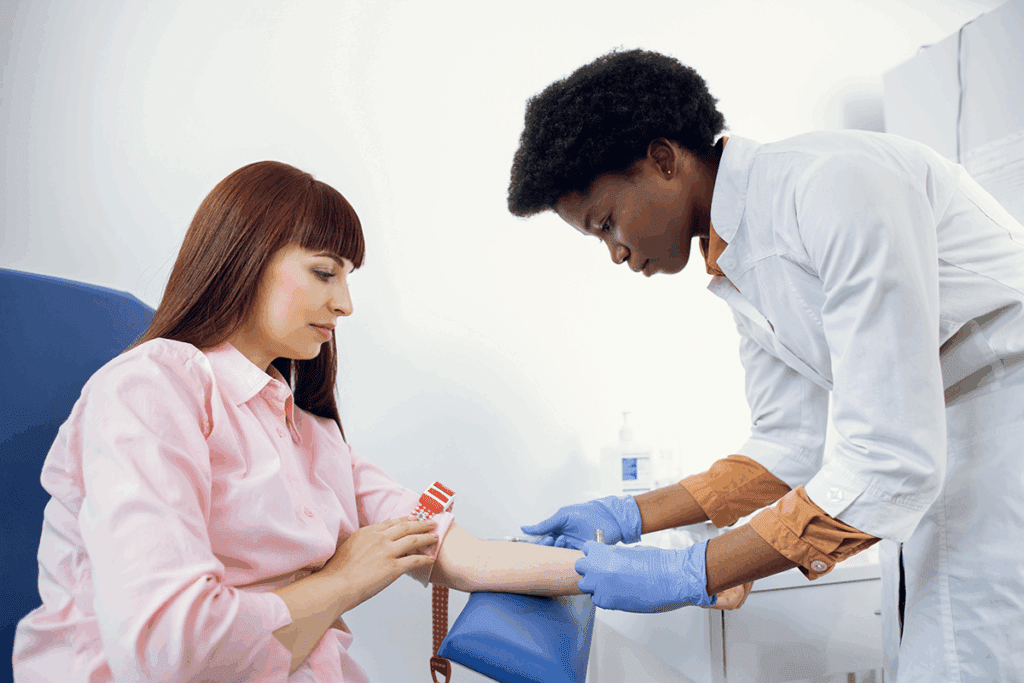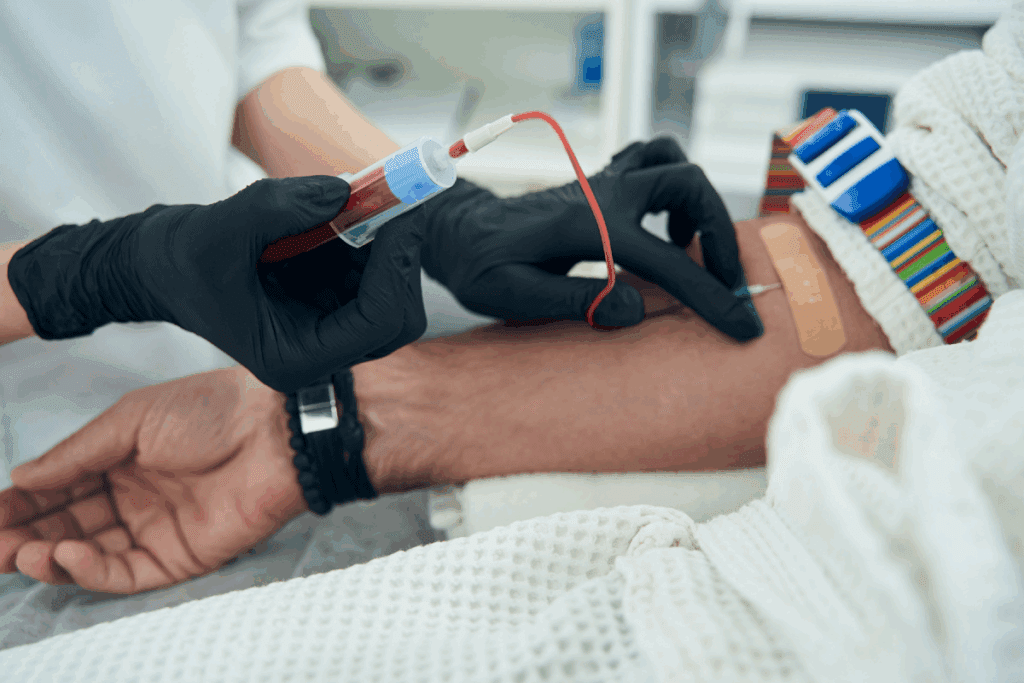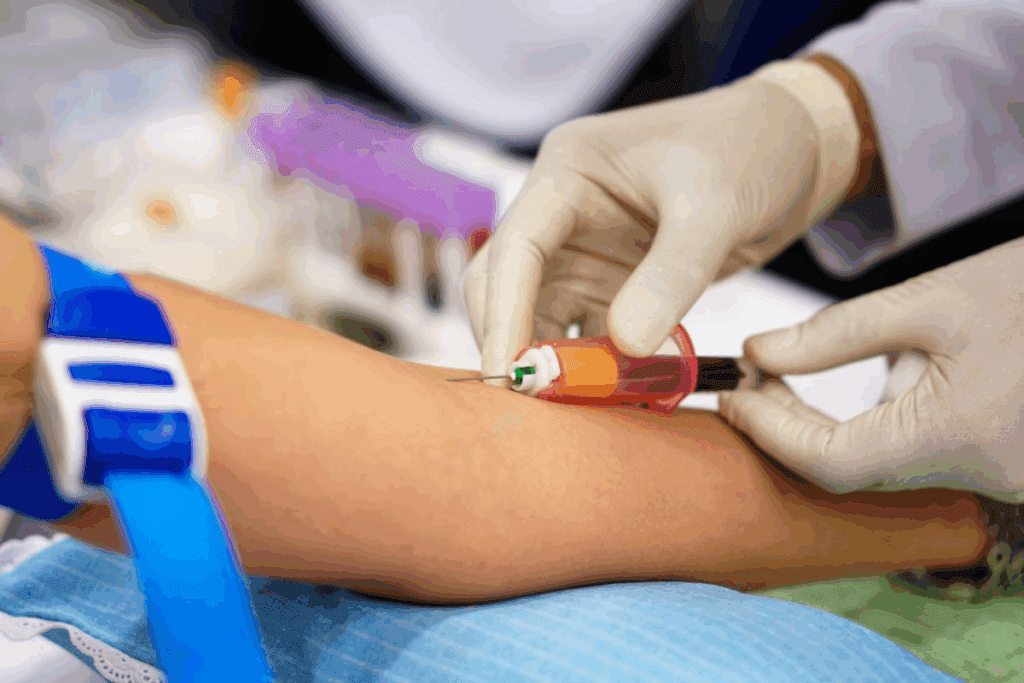Last Updated on November 25, 2025 by Ugurkan Demir

Blood thinner medications are key in keeping our hearts safe. They stop blood clots that could cause strokes, heart attacks, and other heart problems. Discover blood thinning drugs list and common medications that help prevent clots.
At Liv Hospital, we know how important it is to share info on common blood thinner medications. Our list has both old and new medicines. They all help keep our hearts and blood vessels healthy.
We aim to give top-notch healthcare, including help for patients from abroad. Our team makes sure you get the latest and most accurate info on your medicines.

Blood thinners are key to keeping our hearts healthy and preventing blood clots. These medications stop blood clots from forming. This is important because blood clots can cause strokes, heart attacks, and deep vein thrombosis.
Blood thinners, or anticoagulants, help prevent blood clots. They are used to treat and prevent serious health issues. These include strokes, heart attacks, and deep vein thrombosis.
The goal of these medications is to prevent clots without causing too much bleeding. Knowing how they work helps us understand their role in heart health.
Blood thinners work in different ways. Anticoagulants, for example, stop the body’s clotting process. They can block the production of clotting factors or directly stop thrombin or factor Xa.
Antiplatelet medications prevent platelets from sticking together. This action helps prevent arterial thrombi. These clots are often the cause of heart attacks and strokes.
Anticoagulant therapy is used for several heart conditions. Atrial fibrillation, a heart rhythm disorder, increases stroke risk. Anticoagulation is key for these patients.
Deep vein thrombosis (DVT) and pulmonary embolism (PE) also need anticoagulant treatment. This prevents clot progression and recurrence. Patients with mechanical heart valves or high thromboembolic risk also benefit from blood thinners.
Understanding which conditions need blood thinners helps us manage patient care. It reduces the risk of heart-related events.

Blood thinners are divided into two main types: anticoagulants and antiplatelets. Knowing these categories helps find the right treatment for heart conditions.
Anticoagulants stop blood clots from forming or growing. They are called “blood thinners,” but they don’t thin the blood. Instead, they block the clotting process.
Examples include:
These drugs treat and prevent DVT, PE, and stroke in atrial fibrillation patients.
Antiplatelets stop platelets from sticking and forming clots. They are for those who have had heart attacks or strokes, or are at risk.
Common drugs are:
They help prevent arterial thrombosis, which can cause heart attacks and strokes.
Traditional blood thinners, like warfarin, have been used for years. But they need regular INR checks and can interact with many drugs and foods.
Novel oral anticoagulants (NOACs) offer better options. They have a more stable effect, need less monitoring, and interact less with food and drugs.
| Characteristics | Traditional Blood Thinners (e.g., Warfarin) | Novel Blood Thinners (e.g., Apixaban, Rivaroxaban) |
| Monitoring Required | Regular INR monitoring | Limited or no monitoring required |
| Dosing | Variable dosing based on INR | Fixed dosing |
| Food Interactions | Significant interactions with Vitamin K-rich foods | Minimal food interactions |
| Drug Interactions | Multiple possible interactions | Fewer interactions than warfarin |
The table shows how novel blood thinners are better than traditional ones. They are a good choice for many patients needing anticoagulation therapy.
The world of blood thinners is diverse, with different types for different needs. Understanding anticoagulants, antiplatelets, and new blood thinners helps doctors choose the best treatment for patients.
It’s important to know about the different blood thinners out there. They play a key role in keeping our hearts healthy. With so many options, it can get confusing.
Blood thinners fall into two main groups: anticoagulants and antiplatelets. Anticoagulants stop blood clots from forming. Antiplatelets prevent platelets from sticking together.
We’ll dive deeper into these groups. We’ll look at 18 common blood thinners.
Blood thinners work in different ways and are used for various reasons. The main types include:
Each type has several medications. Knowing their uses is key to treating conditions effectively.
Some blood thinners you can buy without a prescription. But many need a doctor’s order. Prescription blood thinners are stronger and used for serious health issues.
Our list includes both prescription and over-the-counter options. It shows why it’s important to get medical advice when taking these drugs.
The 18 common blood thinning drugs are:
Vitamin K antagonists, like warfarin, are a traditional way to thin blood. They are used for conditions like atrial fibrillation, deep vein thrombosis, and pulmonary embolism.
Warfarin stops the liver from making certain clotting factors. This includes factors II, VII, IX, and X. Regular monitoring is key to keep the blood thinning right.
The International Normalized Ratio (INR) checks how well warfarin is working. Regular INR tests help doctors adjust the dose. This keeps the INR between 2.0 and 3.0, avoiding too much blood thinning or clotting.
Warfarin’s effect can change with diet and other medicines. Foods high in vitamin K, like leafy greens, can reduce warfarin’s effect. Some drugs can make warfarin stronger or weaker. Teaching patients about these interactions is vital for safe use.
Managing warfarin carefully is important. This includes regular checks and knowing about interactions. This way, warfarin can be most effective and safest for patients.
DOACs have changed how we treat blood clots. They make taking blood thinners easier. Unlike old blood thinners, you don’t need to get your blood checked often.
Apixaban stops blood clots from forming. It helps prevent strokes in people with irregular heartbeats. It also treats and prevents blood clots in the legs and lungs.
Rivaroxaban is taken once a day. It’s good for preventing strokes and treating blood clots in the legs and lungs.
Dabigatran stops blood clots by blocking a key enzyme. It’s used to prevent strokes and treat blood clots in the legs and lungs.
Edoxaban is a newer blood thinner. It’s used to prevent strokes and treat blood clots in the legs and lungs. It’s taken once a day.
DOACs are great because they work the same way every time. This means you can take them without needing blood tests all the time. This is good for people who need to take blood thinners for a long time.
| DOAC | Mechanism of Action | Dosing Frequency | Primary Indications |
| Apixaban (Eliquis) | Factor Xa inhibitor | Twice daily | Stroke prevention in AF, DVT/PE treatment |
| Rivaroxaban (Xarelto) | Factor Xa inhibitor | Once or twice daily | Stroke prevention in AF, DVT/PE treatment |
| Dabigatran (Pradaxa) | Direct thrombin inhibitor | Twice daily | Stroke prevention in AF, DVT/PE treatment |
| Edoxaban (Savaysa) | Factor Xa inhibitor | Once daily | Stroke prevention in AF, DVT/PE treatment |
In conclusion, DOACs are a big step forward in treating blood clots. They offer more choices for patients and doctors. They work well and don’t need as much monitoring.
Injectable anticoagulants are key in treating blood clots. They help prevent and treat blood clotting issues in different situations.
Unfractionated heparin (UFH) is a common injectable anticoagulant in hospitals. It’s given through an IV or under the skin. It’s mainly used for quick blood thinning during surgeries or for very sick patients.
UFH’s effect is checked with aPTT tests. This helps doctors adjust the dose. But, it needs careful watch because it can cause bleeding.
Low molecular weight heparins (LMWHs) are another type of injectable anticoagulant. They are easier to use because their effects are more predictable. LMWHs are given under the skin and help prevent and treat blood clots.
Examples include enoxaparin (Lovenox) and dalteparin (Fragmin). They don’t need as much monitoring, making them good for patients to take at home. This is because their effects are more stable.
Fondaparinux is a man-made anticoagulant that stops factor Xa in the blood clotting process. It’s given once a day under the skin. It’s used to prevent and treat blood clots in the veins.
Fondaparinux is safe because it doesn’t cause HIT, a rare but dangerous side effect of heparin. Its daily dose makes it easy for patients to follow.
Antiplatelet medications are key in heart health. They help stop blood clots that can cause heart attacks and strokes. This is vital for keeping our hearts safe.
Aspirin is a long-standing choice for heart health. It stops platelets from sticking together by blocking a certain enzyme. Low-dose aspirin is often given to those at high risk of heart problems.
Studies show aspirin helps prevent heart attacks and strokes. But, it can also increase the risk of bleeding.
P2Y12 inhibitors target a specific receptor on platelets. This stops platelets from getting too excited. Clopidogrel and ticagrelor are two common ones used today.
These drugs are often paired with aspirin for people with heart issues or those getting stents. The right choice depends on the patient’s situation and other medications they take.
There are more options like prasugrel and cangrelor. These are for those who can’t use the usual treatments.
New antiplatelet drugs are being developed. This is to make them safer and more effective. As we learn more about platelets, we can better match treatments to each person.
It’s important for patients to know about the side effects of blood thinners. These medications help prevent strokes and heart problems but also have risks. Patients need to understand these risks to manage their treatment well.
Blood thinners can increase the risk of bleeding. Bleeding can range from minor bruising to life-threatening hemorrhages. Patients should watch for signs of bleeding, such as:
To manage bleeding, doctors might adjust the blood thinner dose or stop it temporarily. In severe cases, immediate medical help is needed.
Blood thinners can interact with other drugs, raising bleeding risks or reducing their effect. It’s vital for patients to tell their doctors about all medications, including over-the-counter drugs and supplements. Common interactions include:
Some medical conditions may mean certain blood thinners are not safe. Patients with bleeding disorders or severe kidney disease might need different treatments.
Patients on blood thinners should know when to call for emergency help. Signs needing immediate care include severe bleeding, severe headache or confusion, and trouble breathing. Also, watch for signs of an allergic reaction, like rash, itching, or swelling.
In an emergency, tell doctors about the blood thinner you’re taking. This helps guide treatment and avoid more problems.
Managing blood thinner therapy is a big job. It involves regular checks, watching what you eat, and making lifestyle changes. Doing these things well helps prevent blood clots and bleeding.
Each blood thinner needs its own watchful eye. For example, warfarin patients need regular checks to make sure their blood is just right. It can’t clot too much or too little.
On the other hand, DOACs like apixaban and rivaroxaban don’t need blood tests as often. But, they might need kidney function tests sometimes.
Key monitoring requirements include:
What you eat is very important when you’re on blood thinners, like warfarin. Vitamin K in your food can change how your blood clots. So, eating the same amount of vitamin K-rich foods is key.
Dietary tips for patients on blood thinners:
Changing your lifestyle is important to stay safe on blood thinners. You need to know about the dangers of bleeding. This means being careful with sharp things, wearing safety gear, and watching out for falls.
Safety measures include:
By knowing how to monitor, eat right, and adjust your lifestyle, you can manage your blood thinner therapy well. This helps keep you safe from big risks.
Blood thinner therapy is not a one-size-fits-all solution. It requires tailored approaches for different patients and situations. We must consider various factors to ensure safe and effective use of these medications.
Managing blood thinner therapy is key when patients undergo surgery. It’s important to balance the risk of bleeding against the risk of blood clots. Perioperative protocols vary based on the blood thinner type and the surgery type.
| Blood Thinner | Pre-Surgery Management | Post-Surgery Management |
| Warfarin | Bridging with heparin | Resume warfarin when safe |
| DOACs | Stop 24-48 hours before | Resume when bleeding risk decreases |
Pregnancy adds complexity to blood thinner management. There’s a higher risk of blood clots and effects on the fetus. Low Molecular Weight Heparin (LMWH) is often chosen for its safety during pregnancy.
Older adults face a higher risk of bleeding due to factors like kidney issues and taking many medications. Assessing fall risk is key when prescribing blood thinners to seniors.
Strategies to reduce fall risk include:
In emergency situations, having reversal agents is critical. Different reversal strategies exist for various blood thinners.
| Blood Thinner | Reversal Agent |
| Warfarin | Vitamin K, Prothrombin Complex Concentrate (PCC) |
| Dabigatran | Idarucizumab |
| Apixaban/Rivaroxaban | Andexxa (andexanet alfa) |
Understanding these special considerations helps healthcare providers optimize blood thinner therapy. This minimizes risks and maximizes benefits for patients.
We’ve looked at many blood thinning medicines, like anticoagulants and antiplatelets. They help stop and treat blood clots. Knowing about the different types is key for good treatment.
The list of blood thinners we shared shows many options. From old medicines like warfarin to new ones like apixaban and rivaroxaban. Each has its own good points and possible side effects. This shows why careful use and monitoring are so important.
Managing blood thinners means regular checks, watching what you eat, and making lifestyle changes. It’s also vital to know about drug interactions and who should avoid certain medicines. This includes pregnant women and older adults.
In short, blood thinners are vital for heart health. By knowing how to use them right, we can make them work better and safer. Our talk about blood thinners and treatment shows how important a full approach to heart care is.
Blood thinners stop blood clots from forming or getting bigger. They work by slowing down the body’s clotting process. This is done by stopping the production of clotting factors or by preventing platelets from sticking together.
Anticoagulants, like warfarin and DOACs, stop blood clots by blocking clotting factors. Antiplatelets, such as aspirin and P2Y12 inhibitors, stop platelets from sticking together. This reduces the risk of clotting.
Common blood thinners include warfarin, apixaban, rivaroxaban, dabigatran, edoxaban, aspirin, and clopidogrel. They treat conditions like atrial fibrillation, deep vein thrombosis, and pulmonary embolism.
DOACs, like apixaban and rivaroxaban, have fewer interactions with food and drugs. They don’t need regular INR checks and have a more predictable effect.
The main risk is bleeding. Patients may experience bruising, nosebleeds, and stomach bleeding. In rare cases, bleeding can be severe and life-threatening.
Patients on warfarin should watch their vitamin K intake. It can interact with the medication. A consistent diet and avoiding sudden changes are key. DOACs don’t have vitamin K interactions.
Using blood thinners in pregnancy is complex. It depends on the medication and the patient’s condition. Some, like warfarin, are not safe, while others, like low molecular weight heparins, might be safer.
Look out for severe headache, dizziness, weakness, nosebleeds, heavy menstrual bleeding, and stomach bleeding. If you see these signs, get medical help right away.
Always tell your doctor about all medications you’re taking, including over-the-counter ones and supplements. Some can increase bleeding risk or make blood thinners less effective.
Reversal agents, like idarucizumab for dabigatran and andexanet alfa for apixaban and rivaroxaban, are for emergency situations. They reverse the anticoagulant effect when severe bleeding or urgent surgery is needed.
Avoid activities that increase injury risk, like contact sports. Be careful about falls, which are more dangerous for the elderly or those with mobility issues.
Monitoring frequency varies by medication. Warfarin patients need regular INR checks. DOACs usually don’t require regular monitoring.
No, don’t stop blood thinners without talking to your doctor. Stopping them can increase clot and heart event risks.
Alternatives depend on the condition. Lifestyle changes, like exercise and diet, might be suggested. But blood thinners are often needed to prevent heart events.
Subscribe to our e-newsletter to stay informed about the latest innovations in the world of health and exclusive offers!